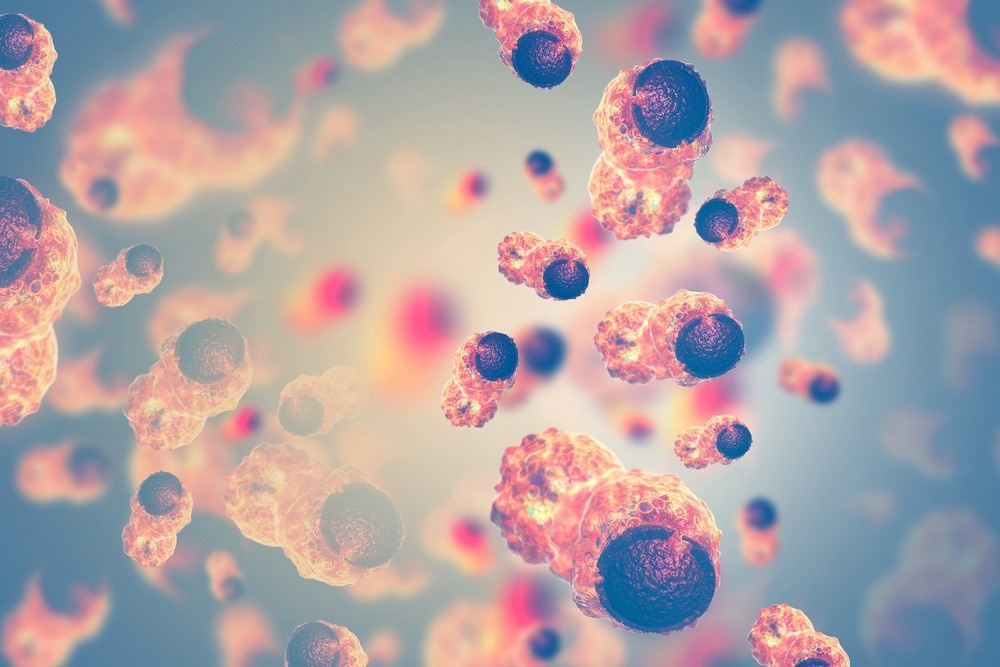An international research team, led by Professor Wenbo Bu of Fudan University and Distinguished Professor Dayong Jin of the University of Technology Sydney, discovered an innovative method to effectively treat cancer by reactivating suppressed metabolic pathways in cancer cells, as published in the prestigious journal Nature Nanotechnology.

Image Credit: crystal light/Shutterstock.com
The researchers employed tyrosine, a common amino acid, as a nanomedicine to alter the metabolism of melanoma, a fatal skin cancer, and prevent the disease from spreading.
Australia has the highest skin cancer rate in the world. This novel technique could be coupled with existing therapies to improve the treatment of melanoma. The approach could potentially be used to treat other forms of cancer.
Tyrosine’s bioavailability is restricted in living beings. However, the researchers employed a novel nanotechnology approach to packaging it into small particles known as nanomicelles. These particles are attracted to cancer cell membranes and rapidly break down, increasing absorption.
The researchers then tested the novel therapy in mice and human-derived melanoma cells in the lab, discovering that the tyrosine nanomicelles awoke dormant metabolic pathways, induced melanin formation, and suppressed tumor development.
Uncontrolled rapid growth is a key feature that distinguishes cancer cells from normal cells. In cancer cells some metabolic pathways are over-activated, and others are suppressed, to create the environment necessary for rapid spread.
Dayong Jin, Distinguished Professor, University of Technology Sydney
He added, “While a few metabolism-based drugs for cancer have been developed previously, such as aromatase inhibitors impeding estrogen synthesis in breast cancer and HK2 inhibitors targeting glycolysis in various cancers, these work by suppressing over-activate metabolic pathways.”
Professor Bu noted, “Our research shows for the first time that cancer can be stopped by reactivating metabolic pathways that are dormant. And this can be done using simple nutrients, such as amino acids, sugars, and vitamins, which are safe, readily available and well tolerated.”
Different nutrients will have varying effects on cancer. Melanoma cells arise from melanocytes, which are skin cells that create melanin. Tyrosine is required to create melanin and can enhance melanin production, which explains its effectiveness with melanoma.
The reactivation of melanin synthesis causes the melanoma cell to lower glycolysis, the process of turning sugar into energy, which is believed to be the reason for its anti-cancer effects.
Melanoma cells are also susceptible to heat stress. The researchers discovered that by combining tyrosine nanomicelle therapy with near-infrared laser treatment, they could remove melanoma in mice within six days, and it did not return during the study time.
The findings point to a possible fresh frontier in using nanomedicine for cancer treatment.
Chen, Y. et al. (2024) Nutrient-delivery and metabolism reactivation therapy for melanoma. Nature Nanotechnology. doi:10.1038/s41565-024-01690-6
- SEO Powered Content & PR Distribution. Get Amplified Today.
- PlatoData.Network Vertical Generative Ai. Empower Yourself. Access Here.
- PlatoAiStream. Web3 Intelligence. Knowledge Amplified. Access Here.
- PlatoESG. Carbon, CleanTech, Energy, Environment, Solar, Waste Management. Access Here.
- PlatoHealth. Biotech and Clinical Trials Intelligence. Access Here.
- Source: https://www.news-medical.net/news/20240620/New-Approach-to-Treating-Melanoma.aspx



